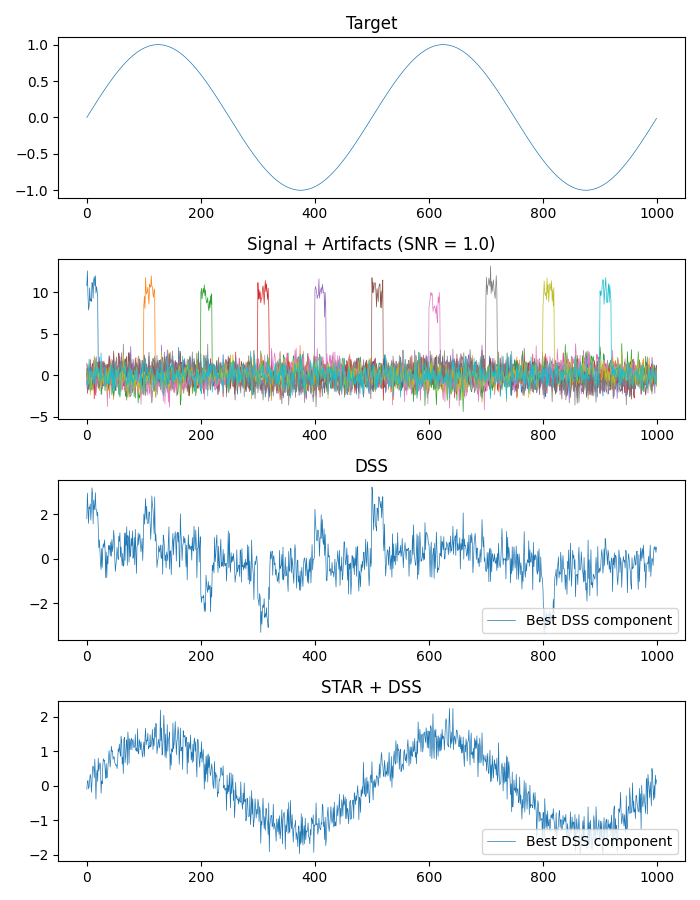Note
Go to the end to download the full example code.
Example demonstrating STAR + DSS#
This example shows how one can effectively combine STAR and DSS to recover signal components which would not have been discoverable with either these two techniques alone, due to the presence of strong artifacts.
This example replicates figure 1 in [1].
References#
import matplotlib.pyplot as plt
import numpy as np
from scipy.optimize import leastsq
from meegkit import dss, star
from meegkit.utils import demean, normcol, tscov
# import config # noqa
rng = np.random.default_rng(9)
Create simulated data#
Simulated data consist of N channels, 1 sinusoidal target, N-3 noise sources, with temporally local artifacts on each channel.
# Source
n_chans, n_samples = 10, 1000
f = 2
target = np.sin(np.arange(n_samples) / n_samples * 2 * np.pi * f)
target = target[:, np.newaxis]
noise = rng.standard_normal((n_samples, n_chans - 3))
# Create artifact signal
SNR = np.sqrt(1)
x0 = normcol(np.dot(noise, rng.standard_normal((noise.shape[1], n_chans)))) + \
SNR * target * rng.standard_normal((1, n_chans))
x0 = demean(x0)
artifact = np.zeros(x0.shape)
for k in np.arange(n_chans):
artifact[k * 100 + np.arange(20), k] = 1
x = x0 + 10 * artifact
def _sine_fit(x):
"""Fit a sinusoidal trend."""
guess_mean = np.mean(x)
guess_std = np.std(x)
guess_phase = 0
t = np.linspace(0, 4 * np.pi, x.shape[0])
# Optimization function, in this case, we want to minimize the difference
# between the actual data and our "guessed" parameters
def func(y):
return np.mean(x - (y[0] * np.sin(t + y[1]) + y[2])[:, None], 1)
est_std, est_phase, est_mean = leastsq(
func, [guess_std, guess_phase, guess_mean])[0]
data_fit = est_std * np.sin(t + est_phase) + est_mean
return np.tile(data_fit, (x.shape[1], 1)).T
1) Apply STAR#
y, w, _ = star.star(x, 2)
proportion artifact free: 0.70
proportion artifact free: 0.70
proportion artifact free: 0.70
depth: 1
fixed channels: 10
fixed samples: 299
ratio: 1.01
power ratio: 0.40
2) Apply DSS on raw data#
c0, _ = tscov(x)
c1, _ = tscov(x - _sine_fit(x))
[todss, _, pwr0, pwr1] = dss.dss0(c0, c1)
z1 = normcol(np.dot(x, todss))
3) Apply DSS on STAR-ed data#
Here the bias function is the original signal minus the sinusoidal trend.
c0, _ = tscov(y)
c1, _ = tscov(y - _sine_fit(y))
[todss, _, pwr0, pwr1] = dss.dss0(c0, c1)
z2 = normcol(np.dot(y, todss))
Plots#
f, (ax0, ax1, ax2, ax3) = plt.subplots(4, 1, figsize=(7, 9))
ax0.plot(target, lw=.5)
ax0.set_title("Target")
ax1.plot(x, lw=.5)
ax1.set_title(f"Signal + Artifacts (SNR = {SNR})")
ax2.plot(z1[:, 0], lw=.5, label="Best DSS component")
ax2.set_title("DSS")
ax2.legend(loc="lower right")
ax3.plot(z2[:, 0], lw=.5, label="Best DSS component")
ax3.set_title("STAR + DSS")
ax3.legend(loc="lower right")
f.set_tight_layout(True)
plt.show()

Total running time of the script: (0 minutes 0.410 seconds)

